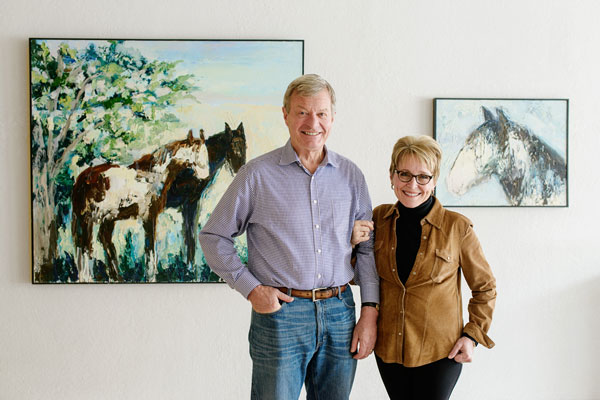
04 Aug Collector’s Eye: Max Baucus & Melodee Hanes
On a quick trip back to Montana from his post as the United States Ambassador to China, Max Baucus and his wife, Melodee Hanes, stopped to talk art at a gallery in Bozeman. Embodying the easy manner of their home state, the politico couple introduced themselves casually with genuine smiles and first names — Max and Mel.
Catching a breath in Big Sky Country, where Baucus served as U.S. Senator from 1978 to 2014, and prior to that as a state representative for four years, the couple was relaxed and gracious in conversation. As a departure from formal dinners and meetings with world leaders discussing Chinese and American policies on trade, climate change, healthcare and human rights, the couple lauded their opportunity to participate in the Art in Embassies program.
Implemented by the Museum of Modern Art in 1953 and formalized by President John F. Kennedy in 1963, Art in Embassies is a lending program founded with the intention of furthering cross-cultural understanding through the visual arts. As part of the State Department’s diplomatic outreach, this public-private partnership has engaged more than 20,000 participants globally, including artists, museums, galleries, universities and private collectors in upwards of 189 countries. Not every ambassador participates in the program, but for Max and Mel it was the ultimate icebreaker.
In 2014, when Baucus left his position as chairman of the Senate Finance Committee “to serve at the pleasure of the president” as ambassador in Beijing, it was the year of the horse in China. A symbol of hard work, diligence and strength, according to the Chinese Zodiac, the horse is one of the country’s most beloved astrological signs.
“It was serendipity when we found out it was the year of the horse,” says Hanes.
Embracing the horse as the theme for the Art in Embassies collection, Max and Mel agreed to incorporate all Montana artists. Introducing American culture to the many guests at the U.S. Ambassador’s Residence is de rigueur; the couple felt art would be an ideal way to showcase Montana’s beauty and present a unique slice of America.
“It definitely helps that we have a personal connection to the art at the residence,” Max said. “Montana is part of who we are, it’s home.”
Based on the Art in Embassies budget, the couple had the option to select prestigious works from The National Gallery and The Smithsonian (Think of it: Da Vinci, Degas, Monet); the previous ambassador had an Andy Warhol. True to their roots, though, they built a collection of Montana artists. Melodee called each artist personally. The list was short, but poignant: Deborah Butterfield, Russell Chatham, Theodore Waddell, Rudy Autio [1926 – 2007], Harry Koyama and Carol Spielman.
The jewel of the collection, a 3,000-pound bronze horse, Isabelle, by sculptor Deborah Butterfield, stands in the entrance of the residence where she welcomes guests as easily as Max and Mel.
WA&A: Were the two of you collectors prior to the Art in Embassies program?
Max Baucus: My mother collected Western art. She was very much an influence in my appreciation for art. We brought a C.M. Russell bronze with us to the private residence in Beijing; it’s a stagecoach. But I haven’t had time to collect, personally.
Melodee Hanes: When we found out about this assignment, we knew we wanted to bring art from that personal collection to the residence in Beijing. And the art in that collection definitely influenced our choices for the Art in Embassies program.
WA&A: What is your most beloved piece in this collection and why?
M.H.: I love them all! Although the Butterfield has been a favorite for most of our guests. It sits at the bottom of the stairs in the entry and is a focal point in that space. So many of our visitors have taken selfies with Isabelle, it’s just great. But the piece in the dining room that Carole Spielman created for that space is stunning. It’s a triptych that people see just as they walk into the room; the title is Welcoming Committee.
M.B.: Each piece reminds me of Montana. When I walk out the door the Russell Chatham landscapes are on either side of the entrance and they make me think of Paradise Valley and Big Timber. But of all of them, it’s the Butterfield. I’ve loved her work for a long time.
WA&A: At what point did you realize you were a collector?
M.B.: I really remember falling in love with art when I was a young man traveling in Amsterdam when I visited the Van Gogh Museum. I wouldn’t call myself a collector, really, but I definitely have an appreciation for art. As a law student at Stanford, the house I lived in had a lending program similar to this one and I went to the library and borrowed a copy of a Miró painting to hang in my bedroom. I always wished I could paint.
WA&A: With which living artist would you most like to have to dinner?
M.H.: I’d invite the artists hanging on our walls.
M.B.: All of them.
WA&A: If you could be any artist in history, who would you be?
M.B.: Ah, Picasso — his work was honest. Maybe Van Gogh, but I’d like to keep my ear (laughs).
M.H.: Mary Cassatt. I love the Impressionists.
WA&A: Where do you imagine your collection will be in 100 years?
M.H.: Art in Embassies is a lending program, so we won’t own this Montana collection. Max’s senate papers were just designated to the University of Montana; it’s my hope that certain pieces in this collection will be gifted to the university when we are done.
M.B.: But as far as our private collection, a lot of works will stay in the family. It was passed on from my mother and I think that’s what will happen to it.






No Comments